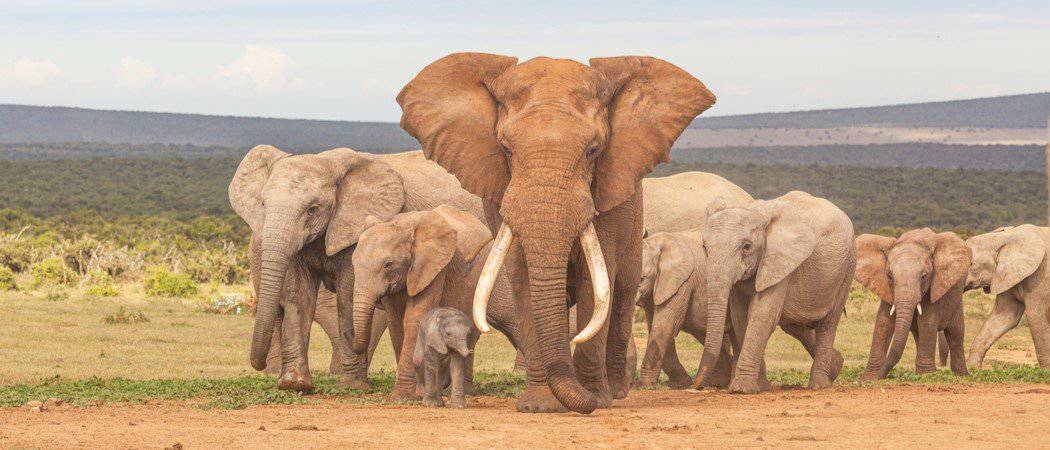
How many years do elephants live in captivity and the average life expectancy of an elephant
This is an amazing animal, the largest of the existing land mammals. There are two types of elephants on the planet: Indian and African. The latter is somewhat larger and differs in the structure of the trunk. In general, this part of the elephant’s body is multifunctional and successfully replaces his nose, arms and even weapons. With the help of a trunk, they eat, drink and breathe, and can also refresh themselves, as if from a shower. Calm and peaceful giants love water treatments and delicious greenery. Fortunately, elephants live in places where you can find both food and water.
Contents
eared giants pretty eat a lot and with appetite. Their breakfast smoothly turns into lunch, gradually flowing into dinner. And so 16 hours in a row. The daily diet of elephants is about half a ton of leaves and branches. As for the liquid, the elephant also drinks abundantly: on hot days or if the animal gets sick, the volume of water drunk reaches 300 liters.
How many years do elephants live in freedom?
The life expectancy of elephants depends on many factors. On average, giants live up to 70 years. Despite the fact that animals are born without teeth, their lifespan depends on the presence of teeth. When the last incisors fall into disrepair, the unfortunate giant faces death from exhaustion. The molars of an elephant change several times, but upon reaching the age of 40, the last change of the dentition takes place, which is subsequently erased very quickly. This circumstance has a significant impact on the number of years he lived.
Moreover, in the natural environment animals are in dangerAs:
- in childhood, become the prey of an insidious and voracious predator;
- not survive another drought that overtakes an elephant several times throughout its life;
- not finding enough water and food;
- be caught by poachers;
The last point is of particular concern to zoologists around the world. The fact is that the tusks of elephants are partially hidden in their body. Poachers in pursuit of profit, because tusks are a very expensive commodity, do not spare unfortunate animals. Moreover, this bone grows throughout life, so the old giants have the longest and most voluminous tusks. Why dishonest hunters do not use the tusks of dead individuals? This is due to the fact that shortly after the death of an elephant, its tusk tusks are eaten by porcupines, thus making up for the lack of minerals. The fact that the population of land giants was exterminated for many years led to its significant decrease and a reduction in the duration of the elephant age.
Is there life in captivity?
In unnatural conditions, these social animals, despite the fact that they does not threaten mortality from illegal human activities or attacks by predatory animals, often live much less than in wildlife. Most zoos, unfortunately, are unable to provide elephants with decent living conditions. And it’s not even about hygiene and nutrition. Under natural conditions, giants live, wandering as part of a large group, covering long distances in a day. In a zoo, however, elephants cannot be provided with sufficient territory for movement and are often forced to break family ties, which inevitably affects the psychological state of the animal.
Why are elephants’ life years shortened in zoo conditions?
Conservationists have long sounded the alarm about the shortening of the years lived by the giants and identified the main problems, which prevent the elephant population from living and developing in captivity for a long time.
- Physical inactivity. Giants need to move a lot in order to survive. In savannah conditions, they cover quite extensive areas, which is impossible in a standard aviary. In captivity, animals are practically deprived of all these benefits. The exceptions are the famous national parks. In addition, elephants must actively swim, dig in the ground, scratch their backs against trees, bathe in mud, they need a natural substrate on which giants usually move. Otherwise, it is possible to infect the legs of elephants. Due to such improper conditions, arthritis develops in animals, which is often the cause of their death.
- neurological disorders. Zookeepers are not always friendly to these beautiful animals. Frequent violence leads to nervous tics and depression in elephants.
- Unsuitable climate. If an elephant is brought to a country with a cold climate, then the confused animal is forced to spend a long time in cramped quarters, and this is a double stress for the heat-loving giant.
- Taking medication. To make the giant seem cheerful, circus or zookeepers use anesthetics and anti-inflammatory drugs. This artificial state, which has been put into the elephant for years, visually smooths out unwanted symptoms acquired in inappropriate conditions.
- Failed reproduction. The birth rate of animals in captivity is unproductive. Cubs often die or are born stillborn, and females, having no good examples, cannot cope with raising their own offspring. Therefore, the life expectancy of small elephants in a zoo is sharply reduced.
Therefore, the loss of habitat negatively affects the quality and duration of elephant years.
elephant facts
Ambiguous and huge animals for many years amaze curious citizens with some interesting details of their lives, as well as psychological and physiological features. Here are just a few of them.
remarkable mind
The weight and structure of the elephant’s brain can only be compared with its aquatic counterpart, equally huge in size – the whale. The average mass of the gray matter of an elephant is 5 kilograms. Land giants are able to experience compassion and joy, have fun and indulge in grief. Always ready to cooperate and highly trainable. For this reason, elephants are used in unique circus performances: drawing with a trunk, opening complex locks.
ritual traditions
For many years, observing animals in nature, people have made interesting conclusions about the attitude of these animals to death. Of course, elephants do not literally bury their dead, but they are very kind to the deceased relatives. This is manifested in the fact that sad giants always go around and remove the bones of dead tribesmen from the road, and are also able to identify them among other remains. In addition, elephants fall into a real depression and mourn the dead members of the herd.
Anatomical features
Surprisingly, despite the hot climate in the habitats of these animals, they are not able to sweat. Physiologically, this process was made impossible by the absence of the corresponding glands. Therefore, elephants are saved from a hot summer either by water procedures or by ears. The vessels in the ears expand and actively give off heat. Thus, the elephant does not get heatstroke.
The following fact is also interesting: huge animals in young years are completely toothless, which in some way makes them related to people.
Spicy detail
Given that female elephants bear offspring for almost two years, they are ready to mate at best once a year. What remains to be done by the stronger sex? Homosexual relationships turned out to be the best way out of a difficult situation. Males sometimes resort to the help of fellow tribesmen in such delicate matters, so same-sex relationships in the herd do not surprise anyone.
elephant society
A structured society in which a hierarchy is clearly traced is a standard herd of big-eared giants. Basically, it contains females of different ages and cubs. Obedience, mutual understanding, care for the sick, the old and the unintelligent reign there. The main one is the most experienced and wise elephant – a mentor of the younger generation. Males stay close to the herd, as they love loneliness. Toddlers grow up among adults for a number of years, and when they reach adolescence, they will have a choice: to stay or start their own family.
Some more facts
Elephants that are out of childhood sleep standing up and are not able to jump and run due to their large weight. And also, oddly enough, they move extremely silently. This is due to the special structure of the foot. It is because of this that they are able to walk even through the swamp.
Amazing giants are both similar and unlike people. They are characterized by compassion and empathy, the giants are not alien to even a sense of humor. Also, the life of an elephant is similar in its duration and structure to a human one: it contains several years of childhood, stages of teenage personality development, the beginning of physical intimacy between individuals, and social relationships. Watching and studying these animals is a true happiness for wildlife lovers.





